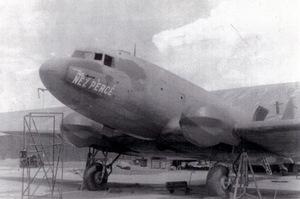Douglas XCG-17
| XCG-17 | |
|---|---|
 |
|
| The XCG-17 during towed flight | |
| Role | Assault glider |
| Manufacturer | Douglas Aircraft |
| First flight | June 14, 1944 |
| Primary user | United States Army Air Forces |
| Number built | 1 |
| Developed from | Douglas C-47 Skytrain |
| Type | Prototype |
| Construction number | 4588 |
| Registration | N69030 XA-JID XC-0PS |
| Serial | 41-18496 |
The Douglas XCG-17 was an American assault glider, developed by the conversion of a C-47 Skytrain twin-engine transport during World War II. Although the XCG-17 was successful in testing, the requirement for such a large glider had passed, and no further examples of the type were built; one additional C-47, however, was converted in the field to glider configuration briefly during 1946 for evaluation, but was quickly reconverted to powered configuration.
With the introduction of the Douglas C-54 Skymaster four-engined transport aircraft, the United States Army Air Forces, observing that conventional gliders then in service would be an inefficient use of the C-54's power and capacity, determined that a requirement existed for a new, much larger assault glider. It was determined that the best solution to the requirement was the conversion of the Douglas C-47 Skytrain, already in large-scale production, to meet the requirement. The C-47 could be converted to a glider configuration with minimal alteration to the airframe, and would provide the required capacity.
Trials conducted using a conventional, powered C-47, first conducting ordinary deadstick landings, then being towed by another C-47, indicated that the scheme was feasible. Therefore, a C-47-DL was taken in hand for conversion into a glider, which was given the designation XCG-17. The aircraft, formerly a Northwest Airlines DC-3 that had been impressed into military service at the start of World War II, was modified by the removal of the aircraft's engines; the nacelles, containing the landing gear, remained in place, covered with aerodynamically profiled hemispherical domes for streamlining, containing fixed weight to compensate for the removal of the engines. Other equipment, no longer necessary with the conversion to an unpowered configuration, was also removed to save weight; items removed included the aircraft's wiring and bulkheads, along with the navigator's and radio operator's positions.
The conversion, carried out at Clinton County Army Air Field, was completed on June 12, 1944, with the aircraft undergoing its initial flight test shortly thereafter. The flight testing of the XCG-17 proved that the aircraft was satisfactory; compared with conventional gliders in service, the aircraft possessed lower stalling and higher towing speeds than conventional gliders, as well as gliding at a significantly shallower angle. Tow tests were conducted using a variety of aircraft; the most commonly used configuration was a tandem tow by two C-47s, with the towing aircraft coupled in tandem and the leading aircraft detaching following takeoff. This configuration was dangerous for the "middle" C-47, however, and it was determined that a single C-54 was the optimal tug aircraft.
...
Wikipedia

